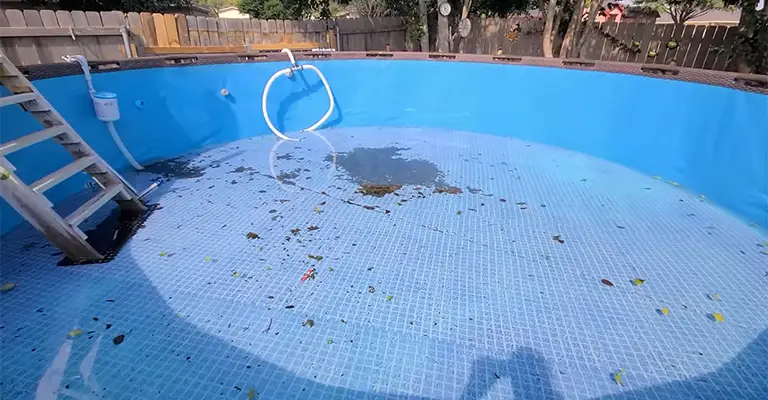Cleaning out an above-ground pool involves removing the water from the pool, just as it does any other part of the process.
Initially, you should drain the pool with a submersible pump. In this way, most of the water level will be reduced. You may have to wait several hours to drain all the pool water, depending on the size of your pool.
When we are cleaning our above ground pools, we need to take note of some key differences.
A Guide To Cleaning An Above Ground Pool Without A Filtration System
You probably have an inflatable pool or something that isn’t meant to be permanently filled if you don’t have a filtration system for your above-ground pool.
The water in these is simply drained and refilled as soon as it shows signs of dirty. Since above ground pools are designed to be drained after a few uses, this is fine for smaller pools.
Before refilling or storing these small above ground pools for a long period of time, you should scrub them thoroughly before refilling or storing them.
Why? It is very likely that the surface of the pool will have dirt, algae, and other nasty stuff on it. Using clean water to refill the pool won’t make sense if it’s in a filthy container!
Here Is How To Clean Your Above Ground Pool After Draining
The following guide will walk you through the process of cleaning your above-ground swimming pool after you drain it.
- Drain the water from the pool
- Any dirt and debris left behind should be picked up/scooped
Scrub down all of the surfaces of your pool with some chlorine dissolved in water or with some pool cleaning solution.
You should be gentle when scrubbing the surface of your above-ground pool to prevent damaging the liner.a
The liner should be refilled with clean water or allowed to dry completely before storing.
For Above Ground Pools With A Filtration System
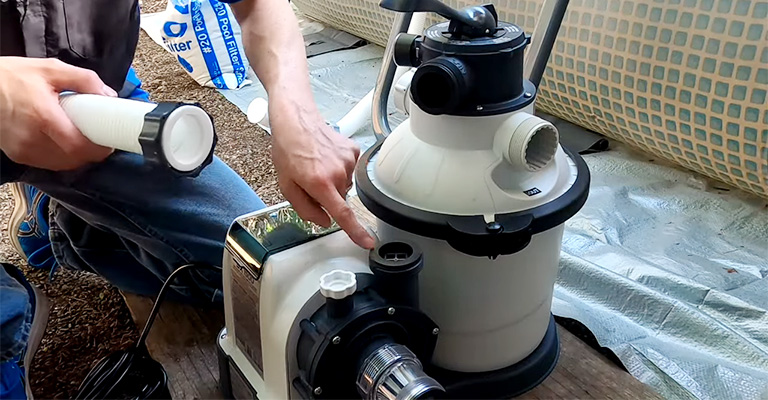
This is where things get interesting. Above ground pools that are larger will feature filtration systems similar to those used in in-ground/permanent pools.
Above-ground pools are usually treated as permanent fixtures, especially larger ones.
Clearing A Cloudy Above Ground Pool
It is more common for above-ground pools to become cloudy. Water like this usually indicates that the pool needs serious treatment because it’s dirty.
There are a number of reasons why above ground pool water can appear cloudy.
You can experience cloudy pools due to dirt, debris, and other environmental factors – trees, bird droppings, weather, small animals, insects, and other creepy crawlies.
Pool filter issues – if you’re running your pool filter for the recommended number of hours and your pool water is still cloudy, it may need cleaning or replacing.
Problems with chemical balance – cloudy pool water may also indicate an issue with your chemical balance.
Getting Rid Of Cloudy Water In An Aboveground Pool
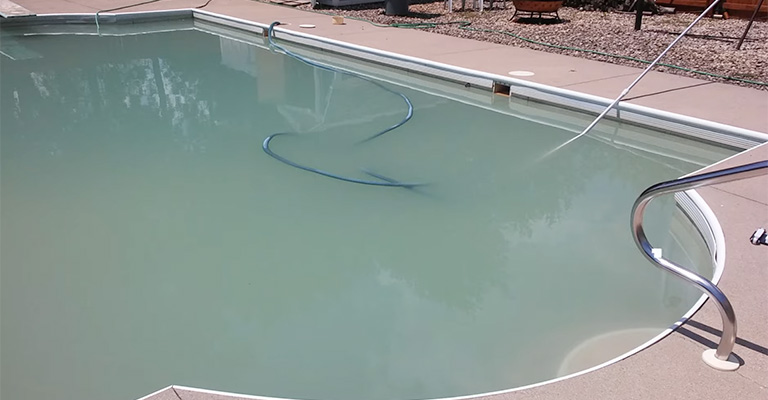
In an aboveground pool, cloudy water can be treated in a couple of ways depending on the cause.
Debris settling at the bottom – Above ground pools don’t have bottom filters and/or drains, which makes filtering them a lot more difficult than regular pools.
In order to counteract this, it is recommended to use a pool vacuum to remove dirt and debris from the bottom of the pool.
Particles that are incredibly small – filters may do an amazing job, but they will have a hard time capturing tiny particles (especially in aboveground pools).
This can be rectified by using clarifiers or clarifying cubes to clump the particles together so that your filter can capture them.
Using floc – when clarifiers and vacuuming are not effective at getting rid of cloudiness, floc is used. You have to work a bit to pull off floc effectively, since it is like a clarifier on steroids.
Take Care Of Housekeeping
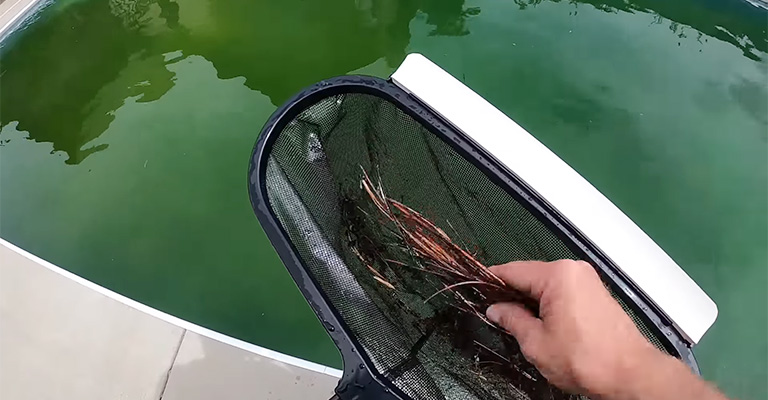
If you want to restore your above-ground pool to full operation, you must ensure that all dirt and grime have been removed from the filter and filter pump.
Replace the filter and filter pump if needed, as well as making sure that they are still fully functional.
After that, you need to check the pool water’s chemical balance with a pool water testing kit to ensure that it is safe to use.
The pH test will provide you with enough information on what chemical levels still need to be maintained for that pool after you have done the test.
Should I Drain My Above-Ground Pool To Clean It?
Despite the fact that above-ground pools are typically cleaned after the winter months, draining vinyl liner pools is not ideal, regardless of whether they are inground or above-ground.
It is also a feature of the pool cover that the pool liner is cut a little small for the actual pool.
The pool liner can, however, stretch a bit when you are assembling your pool due to this design.
It improves the fit of the liner on the pool frame. You will fill up your pool with thousands of liters of water once you fit that liner into the frame for the first time.
The pool liner will stretch significantly more as a result. As a result of that weight, the liner will stay in place as intended.
Once the water is in the pool liner, the internal components become harder.
A liner will shrink back to its original fit when the water is drained out of your above-ground pool, which can be seen by the naked eye as well.
When you fill the pool again with water, the liner will not stretch properly because it has become hard. As a result, you’ll have a liner that’s too small for your pool, which can create a few problems.
You can experience tearing at the seam of your liner, sometimes gradually, sometimes almost instantly.
Also, the liner will want more water and will start pulling away from the top of the pool, where it is attached.
There will sometimes be a cave-in of the pool frame, and there will sometimes be a sudden pop-off of the liner from the pool frame. Neither outcome is ideal.
How To Keep Filter Less Pools Cleaner Longer?
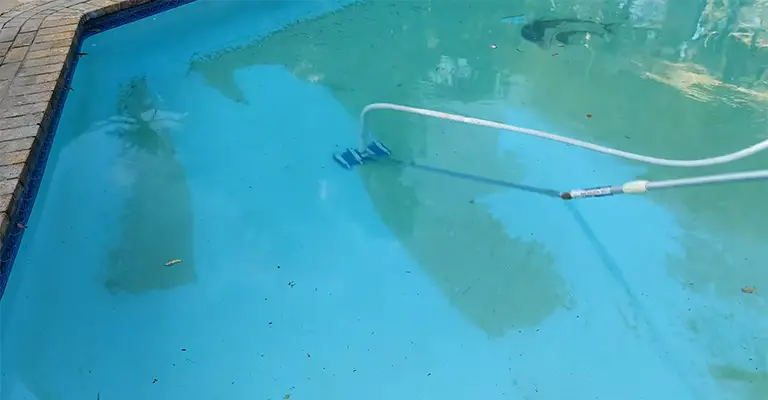
There are a couple of ways to get a cleaner above ground pool without a filter if your pool does not have one, or if it is not designed with a filter.
Use a leaf skimmer – Remove any debris and dirt that falls into your pool to prevent them from breaking down further and contaminating it.
Use a pool cover – When you’re not using your above ground pool, a pool cover keeps dirt, debris, bugs, and other things out.
Use a robotic pool cleaner – this is probably overkill since a robotic pool cleaner will cost more than a filter less above ground pool, but if you have one lying around or know someone who doesn’t use theirs, a robotic pool cleaner can help keep the water clean and filter it out.
Preventing Cloudy Water In An Above Ground Pool
There is always a better way to prevent a problem than to cure it, regardless of whether the pool is in ground or above ground. The best way to prevent cloudy water is to treat your above ground pool as you would an in ground pool!
Remove Debris From The Pool As Soon As It Falls
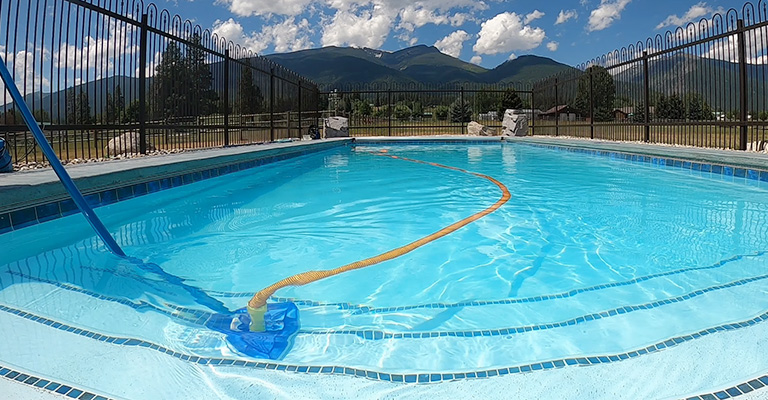
Use a leaf skimmer to scoop out dirt and debris whenever possible if you don’t use a pool cover. If you do this regularly, cloudy water will disappear!
Every Day, Run The Filters At The Recommended Time
It’s important to keep the pool water circulated to make sure that the chemicals work properly.
Moreover, it is passed through the filter to catch any debris or dirt that may cause your pool water to become cloudy or grow algae.
If your baseline reading is higher than the reading on the pressure gauge on your filters, don’t ignore it.
To keep your filters running optimally, clean them out. Consider using some filter cleaning solution if you find your filters are gunked up and a hose down isn’t working.
Regularly Check And Balance Your Pool’s Water
You should check the chemical levels of your above ground pool at least once a week using test strips. Check which levels need balancing and balance them appropriately.
Keeping Your Aboveground Pool Clean
I assume you will want to keep your aboveground pool after all of that, right? In any case, the worst thing you could do is spend hours cleaning your aboveground pool.
Upon waking up in the morning, it’s full of leaves, bugs, and other debris! With a good pool cover, you can reduce the amount of time you need to spend cleaning your aboveground pool.
Bottom Line
It may seem like a monumental task to clean your above-ground pool after draining it, but the truth is, it couldn’t be easier.
Your pool liner can be cleaned easily with a bucket of bleach and a few cleaning supplies.
If you feel as if you have a big task ahead of you, don’t get overwhelmed. You will have a sparkling, clean, and ready-to-use pool liner in no time when you follow these simple steps.

